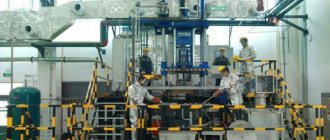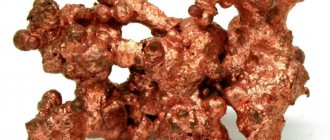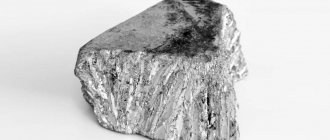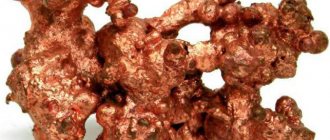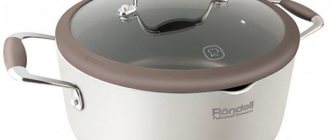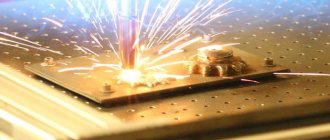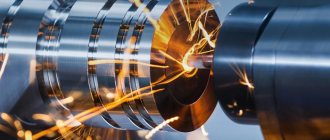Nickel is a high-strength ductile metal with a silvery-white color. It was discovered in 1751 by the Swedish chemist Axel Cronstedt. In the periodic table of D.I. Mendeleev it has number 28 and the symbol Ni, the atomic mass is 58.71.
Nickel is a hard and tough metal with ferromagnetic properties. It lends itself well to welding, forging, stamping and rolling. It is stable in chemically active environments, including alkalis. In atmospheric conditions it is covered with a protective oxide film and does not oxidize even at a temperature of 800 ⁰C.
Physical properties of nickel:
- Melting point - 1455 ⁰С.
- Latent heat of fusion - 73 cal/g.
- Boiling point - 2913 ⁰С.
- Latent heat of evaporation - 1450 cal/g.
- Density - 8800 kg/m3.
- The tensile strength of annealed nickel is 4000−5000 MPa.
- The tensile strength of deformed nickel is 7500−9000 MPa.
- The yield strength of annealed nickel is kg/mm2.
- The yield strength of deformed nickel is 70 kg/mm2.
- Thermal conductivity - 90.9 W/(m*K).
- Electrical resistivity - 0.0684 µOhm*m.
- Elastic modulus - 196−210 GPa.
- Modulus of normal elasticity - 20000 kg/mm2.
- Shear modulus - 7300 kg/mm2.
- The hardness of cast nickel is 60−70 kg/mm2.
- The hardness of annealed nickel is 70−90 kg/mm2.
- The hardness of deformed nickel is 200 kg/mm2.
Due to its properties, nickel in its pure form and especially in alloys is widely used in various fields of industry. The metal forms solid solutions with many elements.
Nickel grades and chemical composition
According to GOST 849-2008, 7 grades of nickel are produced - N0, N1Ау, Н1у, Н1, Н2, Н3 and Н4. They contain from 97.6 to 99.99% nickel in total with a small percentage of cobalt (Co) - from 0.005 to 0.7%. The rest of the mass is occupied by impurities:
- Carbon (C) - found in all grades of nickel.
- Magnesium (Mg).
- Aluminum (Al).
- Silicon (Si).
- Phosphorus (P).
- Sulfur (S) - found in all brands.
- Manganese (Mn).
- Iron (Fe).
- Copper (Cu) - found in all brands.
- Zinc (Zn).
- Arsenic (As)
- Cadmium Cd).
- Tin (Sn).
- Antimony (Sb).
- Lead (Pb).
- Bismuth (Bi).
The detailed chemical composition of different grades of nickel is presented in the table below.
| Brand | Chemical composition, % | |||||||||||||||||
| Ni and co, no less | Including Co, no more | Impurities, no more | ||||||||||||||||
| C | Mg | Al | Si | P | S | Mn | Fe | Cu | Zn | As | Cd | Sn | Sb | Pb | Bi | |||
| H0 | 99,99 | 0,005 | 0,005 | 0,001 | 0,001 | 0,001 | 0,001 | 0,001 | 0,001 | 0,002 | 0,001 | 0,0005 | 0,0005 | 0,0003 | 0,0003 | 0,0003 | 0,0003 | 0,0001 |
| H1Ay | 99,95 | 0,1 | 0,001 | 0,001 | — | 0,002 | 0,001 | 0,001 | — | 0,01 | 0,1 | 0,001 | 0,001 | 0,0006 | 0,0005 | 0,0005 | 0,0005 | 0,0001 |
| H1y | 99,95 | 0,1 | 0,01 | 0,001 | — | 0,002 | 0,001 | 0,001 | — | 0,01 | 0,015 | 0,001 | 0,001 | 0,0005 | 0,0005 | 0,0005 | 0,0005 | 0,0003 |
| H1 | 99,93 | 0,1 | 0,01 | 0,001 | — | 0,002 | 0,001 | 0,001 | — | 0,02 | 0,02 | 0,001 | 0,001 | 0,001 | 0,001 | 0,0001 | 0,001 | 0,0006 |
| H2 | 99,8 | 0,15 | 0,02 | — | — | 0,002 | — | 0,003 | — | 0,04 | 0,04 | 0,005 | — | — | — | 0,1 | — | |
| H3 | 98,6 | 0,7 | 0,1 | — | — | — | — | 0,03 | — | — | 0,6 | — | — | — | — | — | — | |
| H4 | 97,6 | 0,7 | 0,15 | — | — | — | — | 0,04 | — | — | 1,0 | — | — | — | — | — | — | |
Necessary equipment
The following equipment is involved in the nickel processing process:
- Presses (for briquetting).
- Draw machines.
- Converter.
- Shaft furnaces (used for smelting matte). This equipment has a rectangular cross-section, a height of 6 meters, a width of 1.5 meters and a length of 10-15 meters.
- Electric arc furnaces (for nickel reduction).
- Electrolysis baths.
Read about raw materials for nickel production below.
This video will tell you where you can get a small amount of nickel:
The influence of impurities on the properties of the metal
Sulfur is one of the most harmful impurities. It gives nickel red brittleness, due to which the properties of the metal deteriorate during pressure treatment. To neutralize the effect of sulfur, manganese and/or magnesium are added.
Carbon in amounts up to 0.1% does not affect the properties of the metal in any way, however, with a higher content of this element, it falls out of the solid solution during annealing and reduces the ductility of cold nickel.
When the content of bismuth and lead is in an amount of 0.002%, hot metal processing becomes impossible: since these elements are almost insoluble in the solid state, they destroy the ingot. Therefore, in all grades of nickel, the amount of lead and bismuth is limited to 0.001 and 0.0006%, respectively.
Aluminum increases the electrical resistance of nickel. This element is contained in the purest grade - H0. In addition, nickel and aluminum alloys are widely used: they have high heat resistance and corrosion resistance.
Iron does not have a noticeable effect on the properties of nickel. Silicon deoxidizes the base metal, due to which it has a beneficial effect on its casting properties, chemical resistance and strength.
Cobalt increases the heat resistance, heat resistance and strength of nickel, and manganese has a positive effect on the technological and mechanical properties of the metal and improves its electrical resistance.
Price
The price of nickel per 1 kilogram depends on the region. Here is the average price tag throughout the country:
- Nickel - 550 rubles/kg
- Anode, cathode - 650 rubles/kg
- In granules - 650 rubles/kg
How much does nickel and nichrome cost:
- Copper-nickel - 4 rubles/kg
- Alloy containing Ni - 5 rubles/kg
- Nichrome (Х15Н60), if up to 3 mm - 280 rubles/kg, if from 3 mm - 300 rubles/kg
- Nichrome (Х20Н80), if up to 3 mm - 430 rubles/kg, if from 3 mm - 450 rubles/kg
- Wire - 800 rubles/kg
Use of nickel in pure form
To protect metals from corrosion
For this purpose, coatings are used that are applied by electroplating or cladding. The first method is used for aluminum, cast iron, magnesium and zinc, the second - for unalloyed steels and iron.
For the production of metal products that have permanent shapes and high corrosion resistance
Nickel in its pure form is more expensive than iron and steel, so it is used in cases where it is impossible to get by with another metal with a nickel coating. Nickel is used to make crucibles and boilers, tanks for transporting and melting alkalis, storing reagents, food products, etc. Condensates are made in nickel pipes. Tools made from this metal are resistant to interaction with aggressive elements, so they are practically indispensable in chemical laboratories and medical centers. Various nickel devices are used for television, radar and nuclear technology.
As catalysts and filters in the chemical industry
Nickel has the same catalytic properties as palladium, but costs significantly less, so it is widely used in powder form in the hydrogenation reactions of alcohols, unsaturated and aromatic hydrocarbons, and cyclic aldehydes.
Pure nickel powder is also suitable for creating porous filters, which are used to filter various products: fuels, gases, etc.
For mechanical neutron beam choppers.
The properties of nickel make it possible to obtain high-energy neutron pulses, as a result of which plates made of this metal are used in nuclear physics.
Nickel is also used in the manufacture of electrodes in alkaline batteries.
Nickel alloys
In alloys, nickel (together with cobalt) is combined with aluminum, silicon, manganese, iron and chromium. According to GOST 492-73, no more than 1.4% impurities are allowed in them. The impurities contain a small proportion of magnesium, lead, sulfur, carbon, bismuth, arsenic, antimony, cadmium, and tin. A separate group are copper-nickel alloys.
All nickel alloys are divided into four large groups:
- Structural. The peculiarity of these alloys is their high mechanical properties and increased resistance to corrosion. This group primarily includes alloys based on copper-nickel, such as cupronickel, monel, and nickel silver. They are well welded and can be processed cold or hot.
- Heat resistant. The main elements of these alloys are nickel and iron. They are characterized by high heat resistance and heat resistance, and are used primarily for the production of electric heating devices. They are also used for the manufacture of small-sized strain gauges and potentiometric windings.
- Thermoelectrode. These are alloys with high resistivity and high electromotive force. They are used for the production of compensation wires, thermocouples, and precision instruments. This group includes some nickel (chromel, alumel) and copper-nickel (constantan, copel, manganin) alloys.
- Alloys with special properties. This group includes alloys that find special applications due to their unique properties. Invar is an alloy of nickel and iron, which is characterized by increased elasticity. It is used for the manufacture of length standards, measuring geodetic wires, supporting structures of lasers, parts of watch mechanisms, etc. Permalloy is also an alloy of nickel and iron, which has high permeability in magnetic fields. It is used for the production of magnetic circuits, relay parts, transformer cores, etc.
Silicon alloy
Silicon nickel NK 0.2 contains 99.4% nickel (with cobalt), 0.15 - 0.25% silicon and up to 0.45% impurities. Tapes and strips are made from this alloy, which are used in electrical engineering: parts of devices and devices are made from them.
Nickel and manganese alloys
Manganese nickel is produced in four grades - NMTs1, NMTs2, NMTs2.5 and NMTs5. Control grids for mercury rectifiers are produced from NMTs1 alloy. NMTs2 is used in high-strength electronic tubes, used for grid holders, etc. Wire made from NMTs2.5 and NMTs5 alloys is used in engine spark plugs - automobile, aircraft and tractor. NMTs5 is also used for radio tubes.
Alumel
Alumel (NMtsAK 2-2-1) is an alloy of nickel, aluminum, manganese and silicon. It contains 1.60−2.40% aluminum, 1.80−2.70% manganese, 0.85−1.50 silicon, up to 0.7% impurities, the rest is nickel with cobalt (cobalt - up to 1. 2%). Alumel is used for the manufacture of thermocouples, which are used to measure temperature in various fields of industry, automation systems, as well as in medicine and scientific research.
Chromeli
Chromel T (HX 9.5) is an alloy of nickel and 9-10% chromium with an impurity content of no more than 1.4%. Wire for thermocouples is made from this alloy.
Chromel K (HX 9) contains 8.5-10% chromium and up to 1.4% impurities. Wire made from this alloy is used for compensation wires.
The composition of chromel TM (NHM 9.5) includes 9-10% chromium, 0.1-0.6% silicon and up to 0.15% impurities. The alloy is used to make thermocouples.
Chromel KM (NHM 9) is an alloy of nickel, 8.5-10% chromium, 0.1-0.6% silicon with no more than 0.15% impurities. Used for making compensation wires.
Copper-nickel alloys
These are copper-based alloys, with nickel being the main alloying element. The mixture of nickel and copper guarantees high strength, electrical resistance and corrosion resistance.
The elements of copper-nickel alloys can also include aluminum, iron, manganese, zinc, titanium, lead, and silicon. According to GOST 492-73, no more than 2% of impurities are allowed, for some alloys - no more than 0.15%. The most common copper-nickel alloys are copel, constantan, cupronickel, nickel silver, kunial, manganin, monel.
Kopel
Kopel (MNMts43-0.5) contains 0.1-1% manganese, 42.5-44% nickel, up to 0.6% impurities, the rest is copper. The alloy has a high thermoelectromotive force and is produced in the form of wire, which is used for compensation wires, as well as for the manufacture of thermocouples.
Constantan
Constantan (MNMts40-1.5) is a thermostable alloy with high electrical resistivity. It consists of 1-2% manganese, 39-41% nickel, approximately 59% copper and no more than 0.9% impurities. Constantan is produced in the form of wire, strips and tapes. Used for the manufacture of high-precision devices, rheostats and electric heating elements, compensation wires and thermocouples.
Cupronickel
Cupronickel (MNZhMts30-1-1) is a structural copper-nickel alloy containing 18-22% nickel, approximately 80% copper and no more than 0.6% impurities. Some varieties of cupronickel contain iron and manganese. It has high ductility and corrosion resistance. It lends itself well to pressure processing in cold and hot form - stamped, cut, minted. It is easy to solder and polish. Cupronickel has a silvery tint and is available in the form of tubes, strips and ribbons. Used for making coins, inexpensive jewelry and tableware. Tube boards for air conditioners and condenser pipes are made from it. The alloy is also used in instrument making.
Nickel silver
The name nickel silver (MNC15-20) is translated from German as “new silver”. It received this name because it resembles a precious metal, but at the same time it costs much less. Cutlery is made from it, which is silvered after casting. In industry, nickel silver is used for the production of steam and water fittings, medical instruments and parts of precision instruments. Orders and medals, jewelry, and guitar frets are made from it. Nickel silver is also used to make enamel and filigree. The alloy contains 18-22% zinc, 13.5-16.5% nickel, about 38% copper and no more than 0.9% impurities. Available in the form of tape, pipes, strips, wire and rods.
Kunial
Kunial is a dispersion-hardening alloy of copper, nickel and aluminum. Kunial A (MNA13-3) contains 2.3-3% aluminum, 12-15% nickel, about 80% copper and no more than 1.9% impurities. Kunial B (MNA6-1.5) - 1.2-1.8% aluminum, 5.5-6.5% nickel, about 90% copper and no more than 1.1% impurities.
Kunial A is produced in the form of rods and is used in mechanical engineering for high-strength products. Kunial B is used to make strips that are used in electrical engineering for springs and other products.
Manganin
Manganin (MNMts3-12) is a thermostable alloy containing 11.5-13.5% manganese, 2.5-3.5% nickel, about 85% copper and no more than 0.9% impurities. It is produced in the form of sheets and wire, and is used in measuring technology: shunts, coils, additional resistances, resistance magazines, etc. are made from manganin.
Famous manufacturers
Of the producing countries, China, Canada, Russia, Japan and Australia produce the most nickel.
- The largest nickel processing enterprise is the foreign company Inco. Its Kop-per-Cliff nickel smelter is capable of processing about 291 thousand tons of raw materials per year.
- The second place of honor is occupied by the nickel producer (266 thousand tons of raw materials).
- In third place is a foreign enterprise: Jinchuan Group Co. Ltd (150 thousand tons of raw materials). This is a Chinese enterprise. The main office is located in Jinchang (Gansu). The company produces not only nickel, but also selenium, silver, copper, gold, cobalt, palladium and platinum. Performance Jinchuan Group Co. Ltd accounts for 90% of all nickel processing in China. This company is the largest in Asia.
- In fourth place is Glencore International AG (96 thousand tons).
- Fifth place is occupied by BHP Billiton (78.5 thousand tons). This largest enterprise was founded in 2001. BHP Billiton's main office is in Melbourne, Australia, and they have an additional headquarters in London. From a legal point of view, the described enterprise consists of two companies, each of which has a separate owner. In the stock market they exist independently of each other.
There are several other nickel processing enterprises in Russia. These are OJSC Yuzhuralnickel Plant and OJSC Ufaleynickel.
- OJSC MMC Norilsk Nickel has several branches. These are the Western Branch, the Kola MMC and OJSC MMC Pechenganikul. Norilsk Nickel processes mainly sulfide ores, which additionally contain platinum group metals, copper, cobalt and some precious metals. The Kola MMC processes copper-nickel matte, which is delivered to them from outside. This branch does not have its own resources.
- Yuzhuralnickel is located in the Orenburg region. The company mines ore at the following deposits: Buruktalskoye and Sakharinskoye. Ore is processed at the Orsk factory. Yuzhuralnickel uses outdated production technology (they use coke). Therefore, the company's profitability is highly dependent on coal prices.
How nickel is produced at the plant in Norilsk is shown in this video:


